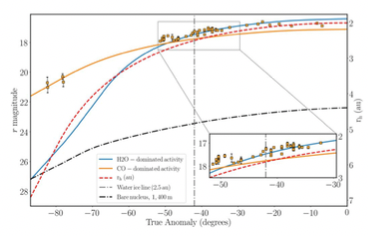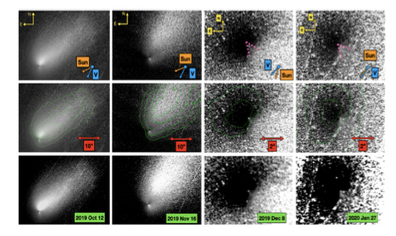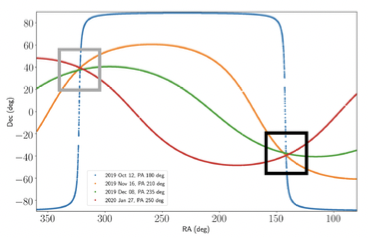VISIR Characterization of the Nucleus, Morphology, Activity, Spin-Pole Orientation & Rotation of Interstellar Comet 2I/Borisov by Earth- and Space-based Facilities
- 1Division of Physics, Mathematics and Astronomy, California Institute of Technology, Pasadena, CA 91125, USA
- 2IPAC, Mail Code 100-22, Caltech, 1200 E. California Blvd., Pasadena, CA 91125, USA
- 3Johns Hopkins University Applied Physics Laboratory, Laurel, MD 20723, USA
- 4Department of Astronomy, San Diego State University, 5500 Campanile Dr., San Diego, CA 92182, USA
- 5Kavli Institute for the Physics and Mathematics of the Universe (WPI), The University of Tokyo Institutes for Advanced Study, The University of Tokyo, Kashiwa, Chiba 277-8583, Japan
- 6Physics Department, Leach Science Center, Auburn University, Auburn, AL 36832, USA
- 7Université Côte d’Azur, Observatoire de la Côte d’Azur, CNRS, Laboratoire Lagrange, Boulevard de l’Observatoire, CS 34229, F-06304 Nice cedex 4, France
VISIR Characterization of the Nucleus, Morphology, Activity, Spin-Pole Orientation & Rotation of Interstellar Comet 2I/Borisov by Earth- and Space-based Facilities
Bryce T. Bolin (1,2), Carey M. Lisse (3), Mansi M. Kasliwal (1), Robert Quimby (4,5), Dennis Bodewits (6), Alessandro Morbidelli (7), George Helou (2)
(1) Division of Physics, Mathematics and Astronomy, California Institute of Technology, Pasadena, CA 91125, USA (bbolin@caltech.edu)
(2) IPAC, Mail Code 100-22, Caltech, 1200 E. California Blvd., Pasadena, CA 91125, USA
(3) Johns Hopkins University Applied Physics Laboratory, Laurel, MD 20723, USA
(4) Department of Astronomy, San Diego State University, 5500 Campanile Dr., San Diego, CA 92182, USA
(5) Kavli Institute for the Physics and Mathematics of the Universe (WPI), The University of Tokyo Institutes for Advanced Study, The University of Tokyo, Kashiwa, Chiba 277-8583, Japan
(6) Physics Department, Leach Science Center, Auburn University, Auburn, AL 36832, USA
(7) Université Côte d’Azur, Observatoire de la Côte d’Azur, CNRS, Laboratoire Lagrange, Boulevard de l’Observatoire, CS 34229, F-06304 Nice cedex 4, France
We present visible and near-infrared photometric and spectroscopic observations of interstellar object 2I/Borisov taken from 2019 September 10 to 2020 January 27 using ground-based facilities FROM the ZTF, the Keck Telescope, the GROWTH network, the APO ARC 3.5m, & the NASA/IRTF 3.0m combined high-resolution observations from HST. The photometry, taken in filters spanning the visible and NIR range shows 2I having a reddish object becoming neutral in the NIR. The lightcurve from recent and pre-discovery data reveals a brightness trend suggesting the recent onset of significant H2O sublimation with the comet being active with super volatiles such as CO at heliocentric distances >6 au consistent with its extended morphology (Fig. 1., left panel). Using the advanced capability to significantly reduce the scattered light from the coma enabled by high-resolution NIR images from Keck adaptive optics taken on 2019 October 04, we estimate a diameter of 2I's nucleus of <1.4 km. We use the size estimates of 1I/'Oumuamua and 2I/Borisov to roughly estimate the slope of the ISO size-distribution resulting in a slope of ~3.4+/-1.2 (Fig. 1, right panel), similar to Solar System comets radii > 1 km (Boe et al. 2019).
We combine our deep imaging of interstellar comet 2I/Borisov taken with the Hubble Space Telescope/Wide Field Camera 3 (HST/WFC3) on 2019 December 8 UTC and 2020 January 27 UTC (HST GO 16040, PI Bolin) before and after its perihelion passage in combination with HST/WFC3 images taken on 2019 October 12 UTC and 2019 November 16 UTC (HST GO/DD 16009, PI Jewitt) before its outburst and fragmentation of March 2020, thus observing the comet in a relatively undisrupted state. We locate 1-2” long (2,000 - 3,000 km projected length) jet-like structures near the optocenter of 2I that appear to change position angles from epoch to epoch (Fig. 2, left panel). With the assumption that the jet is located near the rotational pole, we determine that 2I's pole points near RA = 322 deg, dec = 37 deg, ecliptic longitude = 341 deg, ecliptic latitude = 48 deg (Fig 2., right panel). We find evidence for periodicity in the time-series lightcurve explained by a nucleus rotation period of ~10.6 h and small amplitude of ~0.05 implying a b/a axial ratio of ~1.5 when combined with our pole solution, unlike the b/a of 4 to 10 found for 1I/`Oumuamua (Bolin et al. 2018). Unless 2I's nucleus was <200 m in size and was spun up rapidly by a pronounced jet after our observations, the March 2020 outburst (Drahus et al. 2020) and fragmentation (Bolin et al. 2020b, Jewitt et al. 2020) was most likely due to calving caused by thermal effects.
References:
Boe et al. 2019. Icarus, Volume 333, p. 252-272., Bolin et al. 2018. ApJL, 852, L2., Bolin et al. 2020a, AJ, 160, 16pp., Bolin et al. 2020b, ATel, 13613., Drahus et al. 2020, ATel, 13549., Fitzsimmons et al. 2019. ApJL, 885, L9., Jewitt et al. 2020, arxiv:2006.01242.

Figure 1. Left panel: r magnitude of 2I as a function of the true anomaly using photometry taken between 2019 March 17 and 2019 November 29 UTC. The blue and orange lines are the predicted brightness as a function of true anomaly angle for H2O and CO-dominated activity comet from the out-gassing model of 2I from Fitzsimmons et al. 2019. Right panel: the size distribution of ISOs within 3 au of the Sun estimated from the detection of 1I with D~250 m and 2I with D~1.4 km. The solid grey line is fit to data with the function y = axb and is based on the estimated size of 1I from the literature and the average of the upper limits on the diameter of 2I assuming 0.04 and 0.1 albedo where a = 0.12 +/- 0.05 and b = 3.38 +/- 1.18.


Figure 2. Left panel: Mosaic of radial profile normalized composite images of 2I taken with HST on 2019 October 12 UTC and 2019 November 16 UTC using the F350LP filter (HST GO/DD 16009, PI Jewitt) and on 2019 December 8 UTC and 2020 January 27 UTC using the F689M and F845M filters (HST GO 16040, PI Bolin) A south-facing jet is observed in the near-nucleus coma in the images taken on 2019 October 12 and 2019 November 16 and a south-west facing jet is observed in the December 8 UTC and 2020 January 27 images (outlined by the dotted purple wedges). Right panel: Pole/line-of-sight planes from our 4 observing dates. The intersection zone of around RA = 322 deg, dec = 37 deg in the grey square defines the rotation axis with an uncertainty of ~10 degs.
How to cite: Bolin, B., Lisse, C., Kasliwal, M., Quimby, R., Bodewits, D., Morbidelli, A., and Helou, G.: VISIR Characterization of the Nucleus, Morphology, Activity, Spin-Pole Orientation & Rotation of Interstellar Comet 2I/Borisov by Earth- and Space-based Facilities, Europlanet Science Congress 2020, online, 21 September–9 Oct 2020, EPSC2020-479, https://doi.org/10.5194/epsc2020-479, 2020

